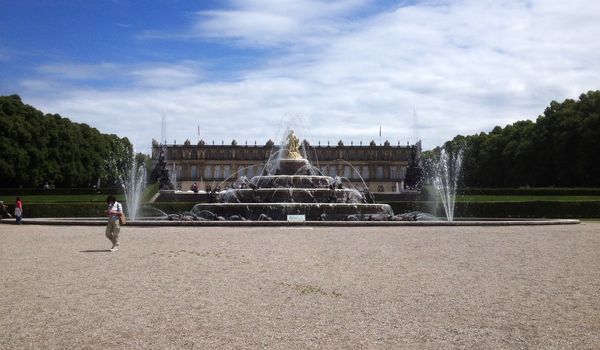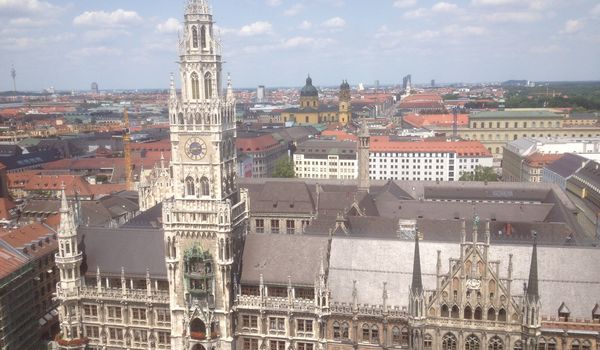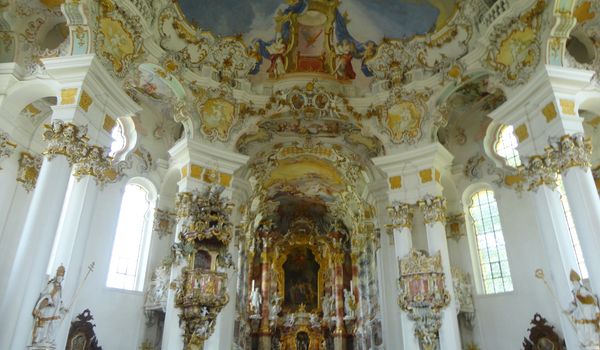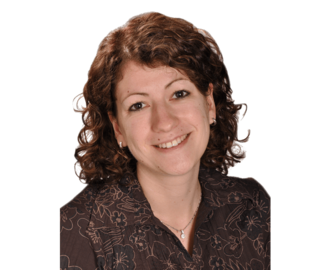Day 1: Arrival in Munich
Dinner and overnight in Munich.
Day 2: Munich
Today you discover Munich. The capital of Bavaria is situated in the north of the Alps and on the banks of the river Isar. Munich is the third biggest city in Germany, following Berlin and Hamburg. The city’s slogan is “München mag dich” (Munich loves you). The word “Munich” derives from the old German “Munichen” and means “close to the monastery”, due to the presence of Benedictine monks who have founded the town. In 2010, the magazine Monocle ranked Munich the most livable city in the world. In the morning, you have the possibility to take a combined city tour by bus and foot to see the most spectacular attractions of the city: Isartor, Marienplatz Square, Sendlinger Tor, Stachus Square, Palace of Justice, the three art galleries of Pinakothek, the quarters of Schwabing and Bogenhausen, the boulevards Leopold, Ludwig and Maximilian, the university, Odeon’s Square with the Feldherrenhalle, the churches Theatiner and Frauenkirche, the Maximilianeum as well as the famous Hofbäuhaus (the biggest beer hall in Munich). During the visit, you will enjoy many sights and interesting stories! In the afternoon, you will visit the Pinakothek. The name derives from Greek and means art gallery. The Old Pinakothek is an art museum situated in the artist’s quarter of Munich – the “Kunstareal”. It is one of the oldest art galleries in the world and hosts the famous exposition “Alte Meister”. The Old Pinakothek exposes this period of art, whereas the New Pinakothek displays art from the 19th century and the Pinakothek of Modern Art covers contemporary artwork. Those three art galleries are part of the Bavarian State Picture Collection. Dinner and overnight in Munich.
Day 3: The Island of Herrenchiemsee and its Palaces
After breakfast, you depart for Prien on the lakefront of Chiemsee. Here, you will take the boat to the island of Herrenchiemsee. This island has an area of 240 hectares and numerous panoramic views to offer. Highlights are amongst others the Royal Palace with its park and water fountains as well as the museum and the two art galleries of the Augustinian monastery. You will visit the New Palace, the museum of King Ludwig II of Bavaria and the galleries.
The New Palace: In 1873 King Ludwig II of Bavaria acquired the Herreninsel as the location for his Royal Palace of Herrenchiemsee (New Palace). Modelled on Versailles, this palace was built as a "Temple of Fame" for King Louis XIV of France, whom the Bavarian monarch fervently admired. The actual building of this "Bavarian Versailles", which was begun in 1878 from plans by Georg Dollmann, was preceded by a total of 13 planning stages. When Ludwig II died in 1886 the palace was still incomplete, and sections of it were later demolished. The highlights of the large state rooms are the State Staircase, the State Bedroom and the Great Hall of Mirrors. The king's own rooms were in the intimate Small Apartment, designed in the French rococo style. In 1876 Court Garden Director Carl von Effner completed the plans for a large garden resembling that of Versailles. When the king died, only the sections along the main axis with their famous fountains and waterworks had been completed.
King Ludwig II Museum: The museum is accommodated in twelve modernized rooms on the ground floor of the south wing and was opened in 1987. It documents the story of Ludwig II's life from his birth to his tragic early death with painted portraits, busts, historic photographs and original state robes. The king went down in the history of music as patron of the composer Richard Wagner. Portraits, written documents and theatre and stage set models record this aspect of his life. The "royal residences" of Neuschwanstein Castle, Linderhof Palace and Herrenchiemsee Palace are represented as well as Ludwig II's other building projects. Highlights of the museum include the magnificent furniture that originally stood in the destroyed royal apartment in the Munich Residenz and the first bedroom of Linderhof Palace. Elaborately handcrafted items, showpieces that were commissioned by the king, document the European standing of court art in Munich in the second half of the 19th century.
Augustinian Monastery (Old Palace): The present monastery building on Herrenchiemsee was constructed in the baroque era. The four wings enclose a large, almost rectangular courtyard with an idyllic rose garden. The convent tract (east wing) with halls and monks' cells was built in 1645-49, the brewery tract (west wing) in 1661-65. In the princes' tract (south wing), which dates from 1700-16, were the monastery kitchen, state halls and accommodation for noble guests. The courtyard was closed off with the prelacy tract (north wing), built in 1727-30. In 1998 a modern internal link museum was opened in the convent tract and princes' tract. The prelacy tract (north wing) houses the internal link Julius Exter Art Gallery with around 100 works of the artist. The "Platanensaal" (Hall of Planes) with its view of the Fraueninsel was planted in 1893.
En route back to Munich, you will have the chance to stop by Rosenheim. During your visit, you will visit the park “Salinengarten”. Since 1987 the Salingarten, in front of the Culture and Congress Centre Ku'Ko, has been used as a sculpture garden. Large sculptures by important sculptors from Rosenheim and environment can be seen here. Afterwards, you will see the most important attractions of Rosenheim, like Gillitzerblock, Max-Josef Square, the church of Heilig-Geist, Mittertor (the oldest building in town; on the façade to the side of the square is the emblem of Louis Rosenheim, with the white rose against a red background), the city hall and many more. Dinner and overnight in Munich.
Day 4: Wieskirche, Neuschwanstein & Linderhof
Today you go on excursion to Oberammergau. En route, you stop at Wieskirche. The Pilgrimage Church of Wies (German: Wieskirche) is an oval rococo church, designed in the late 1740s by Dominikus Zimmermann. It was added to the UNESCO World Heritage List in 1983 and underwent extensive restoration between 1985 and 1991. The entry is free of charge, a donation is highly appreciated, though. Please note that a visit during Mass is not possible. Afterwards, you visit the castle of Neuschwanstein. Seven weeks after the death of King Ludwig II in 1886, Neuschwanstein was opened to the public. The shy king had built the castle in order to withdraw from public life – now vast numbers of people came to view his private refuge. Today Neuschwanstein is one of the most popular of all the palaces and castles in Europe. The setting of Neuschwanstein could not be more idyllic. The tour of the palace (with English audio guide) begins with a view into the servants' rooms with authentic oak furnishings on the first upper floor. The rooms on the second floor were never finished and today house a shop, a cafeteria and a multimedia room. The apartments and state rooms of the king are on the third and fourth floors. In the afternoon, you will go to the castle of Linderhof. Ludwig II, who was crowned king in 1864, began his building activities in 1867/68 by redesigning his rooms in the Munich Residenz and laying the foundation stone of Neuschwanstein Castle. In 1868 he was already making his internal link first plans for Linderhof. However, neither the palace modelled on Versailles that was to be sited on the floor of the valley nor the large Byzantine palace envisaged by Ludwig II were ever built. Instead, the new building developed around the forester's house belonging to his father Maximilian II, which was located in the open space in front of the present palace and was used by the king when crown prince on hunting expeditions with his father. Linderhof Palace, the eventual result of a long period of building and rebuilding, is the only large palace King Ludwig II lived to see completed. Dinner and overnight in Munich.
Day 5: Passau & Regensburg
After breakfast, you depart for Passau which is a town in Lower Bavaria. It is also known as the Dreiflüssestadt or "City of Three Rivers," because the Danube is joined at Passau by the Inn from the south and the Ilz from the north. You will start you day at Passau with a boat cruise experiencing the city from a different perspective. Passau was the largest diocese of the Holy Roman Empire for many years. Explore the city’s historic center with its towers, picturesque squares, and winding alleys. During your guided city tour you will visit St. Stephen's Cathedral. Enjoy the beauty of Passau! In the afternoon, you will arrive to Regensburg – the northern most city of the Danube. The large medieval center of the city is a UNESCO World Heritage Site. In the old town there are 1,200 historic buildings which you will discover with your guide. Despite its historical architecture, Regensburg is also well-known for its “Historische Wurstküche,” a historic kitchen where you can eat the best sausages. After a culinary stop, you continue to Walhalla. The Walhalla is a hall of fame that honors laudable and distinguished German personalities. It is housed in a neo-classical building above Danube River, and comprehends 129 busts of famous Germans. In the late afternoon, you will drive to Nuremberg. Dinner and overnight in Nuremberg.
Day 6: Nuremberg & Bamberg
In the morning, your guide will take you on a city tour of Nuremberg, which was an imperial city and international center of commerce. Additionally, it was an early center of humanism, science, printing, and mechanical invention. Today, the city still has many monuments, buildings and artwork which reflect this historic importance. During the city walk you will learn a lot about Nuremberg’s history and see the most famous sights, like the castle, the market square as well as numerous churches. After lunch, you continue to Bamberg. This city is not only known for its rich cultural patrimony, but also for winegrowing and market gardening. Bamberg is divided into three parts: The upper town with its narrow and winding alleys, baroque façades and its medieval appearance; the island’s town which is the vibrant center today; and the town of the market gardeners with its vast agricultural land and typical houses. Let yourself be enchanted by the unique atmosphere and facet of Bamberg! Dinner and overnight in Nuremberg.
Day 7: Wurzburg & Rothenburg
You start your day with a guided tour of Wurzburg. You will visit Marienkapelle on the market square, and see replicas of the statues of Adam and Eve by Riemenschneider at the entrance. Next to the Marienkapelle you will find the “Haus zum Falken,” with its splendid façade which is an achievement of the Wurzburg rococo period. Passing by at the historic city hall and cathedral, you will end your tour on Marienberg. Here, you can enjoy a wonderful view from the fortress and its surrounding vineyards! After lunch break, you will enter Marienberg fortress. The original castle on the Marienberg, a hill which was first settled in the late Bronze Age, was probably a small fort built early in the 8th century by the Franconian-Thuringian dukes, together with a church which in 741 became the first church of the Wurzburg bishops. From 1200 an unusually large castle was built, which was extended during the late Middle Ages and the Renaissance. Following the storming of the castle in 1631 by the Swedes, Prince-Bishop Johann Philipp von Schönborn built a circle of massive bastions to protect it. In 1945 the fortress was almost completely burned out, and its reconstruction was only completed in 1990. Afterwards, you continue your travels northwards. Your next stop will be Rothenburg. While exploring the city with your guide, you will learn a lot about Rothenburg’s interesting history and its buildings, like famous St. James' Church. Dinner and overnight in the area of Heidelberg.
Day 8: Heidelberg
After breakfast, your guide will show you around in Heidelberg. Being situated between the river Neckar and the foothills of Odenwald, Heidelberg is the oldest University city of Germany. The famous castle is set against the deep green forests on the north flank of Königstuhl hill, the red sandstone ruins tower majestically over the Neckar valley. Descending from the castle, you will arrive to the old town where you will find the historic market square with one of the most beautiful fountains Heidelberg has to offer. Here, you will admire the Baroque style houses and The Church of the Holy Spirit, a late Gothic church. Afterwards, you will take a boat tour on the river Neckar, and finally visit a winery where you can, of course, taste its best wines! Dinner and overnight in the area of Heidelberg.
Day 9: Mainz & Frankfurt
Today you leave for Mainz – the city of Gutenberg. Mainz has been many things to many people: the Roman Castrum Moguntiacum, the Jewish Magenza, the residence and capital of the Prince Electors, an archbishopric, a university town and a fortified city of the Holy Roman Empire of the German Nation. The most famous building of Mainz is its cathedral. The foundation stone for the cathedral was laid in 975, modelling it on old St. Peter’s in Rome. Surrounding the cathedral, you will find medieval Old Town and its zick-zack alleys with their funny names like Little Nose Way, Hering’s Fountain Alley or Corpse Yard. Broad, roomy squares, lovingly-restored half-timbered houses and magnificent Baroque churches give Old Town its charming character. Hidden behind its Rococo façades and hidden in its bourgeois Baroque houses are elegant boutiques, cafés, and wine bars clamoring for your attention. Despite of Old Town, Mainz also offers buildings of modern age, like Rheingoldhalle and the city hall, as well as buildings of Baroque and Renaissance style, e.g. Electoral Palace and New Armory. Romano-Germanic Central Museum and Gutenberg Museum are also worth visiting! In the afternoon, you continue to your last stage: Frankfurt. The unique skyline, the city’s premier sightseeing attraction, is visible for miles. Frankfurt is the largest financial center in continental Europe and ranks among the world's leading financial centers. It is home to the European Central Bank, Deutsche Bundesbank, Frankfurt Stock Exchange and several large commercial banks. During your guided tour, you will discover historic and modern Frankfurt by seeing the Romer, Frankfurt Cathedral and St. Paul’s Church as well as Goethe House and Jews’ Alley. Frankfurt is also home to Germany’s most celebrated museum landscape, offering its guests a colorful variety of cultural highlights throughout the year. Set side by side like pearls on a string, the museums of Frankfurt’s famous museum embankment regularly present spectacular exhibitions of international renown. Dinner and overnight in Frankfurt.
Day 10: Departure
Copyright program and pictures: © APPINA TRAVEL GmbH



